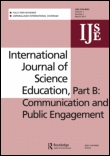
International Journal of Science Education Part B-Communication and Public Engagement
Scope & Guideline
Connecting researchers and practitioners in science education.
Introduction
Aims and Scopes
- Science Communication and Public Engagement:
The journal emphasizes the importance of effective science communication strategies and public engagement practices, particularly in informal settings such as science festivals, museums, and community-based programs. - Educational Methodologies and Practices:
It explores various educational methodologies, including mixed methods, storytelling, and interactive learning, to improve science education and promote scientific literacy among different demographics. - Citizen Science and Community Involvement:
The journal highlights the role of citizen science as a tool for education and community engagement, focusing on how public participation can enhance scientific understanding and foster environmental stewardship. - Innovative Use of Technology in Science Education:
It investigates the integration of modern technologies, such as virtual reality and augmented reality, into science education, aiming to make learning more engaging and accessible. - Socioscientific Issues and Decision Making:
The journal addresses how science education can influence decision-making processes related to socioscientific issues, emphasizing critical thinking and reasoning skills among students.
Trending and Emerging
- Interdisciplinary Approaches to Science Communication:
There is a growing trend towards interdisciplinary studies that combine insights from education, psychology, and sociology to enhance science communication practices. - Inclusivity and Accessibility in Science Education:
The journal increasingly addresses themes of inclusivity, focusing on how science education can be made accessible to diverse populations, including individuals with disabilities and underrepresented groups. - Impact of Social Media on Science Communication:
Recent publications are exploring the role of social media in shaping public perceptions of science, particularly in the context of misinformation and engagement during crises like the COVID-19 pandemic. - Community-Centric Science Engagement:
Emerging themes focus on community-centric approaches to science engagement, emphasizing the importance of local contexts and community needs in science communication efforts. - Emotional and Narrative Dimensions of Science Communication:
There is an increasing focus on the emotional and narrative aspects of science communication, investigating how storytelling and emotional engagement can enhance public understanding of science.
Declining or Waning
- Traditional Science Education Models:
There is a noticeable decline in papers focused solely on traditional science education models without integration of public engagement or innovative practices, as the journal shifts towards more interactive and participatory approaches. - General Science Literacy:
Discussions solely centered on general science literacy are waning, with a shift towards more specific themes that link literacy to public engagement and community involvement. - Focus on Higher Education:
There is a reduction in studies exclusively examining higher education settings, as the journal increasingly emphasizes K-12 education and community engagement contexts. - Static Science Communication Strategies:
Papers discussing static or one-way science communication strategies are becoming less common, as the journal promotes dynamic and interactive forms of communication that foster dialogue and engagement.
Similar Journals

Sociologia Nauki i Tehnologij-Sociology of Science & Technology
Shaping the Future Through Critical Analysis of Science and TechnologySociologia Nauki i Tehnologij-Sociology of Science & Technology is a distinguished journal dedicated to exploring the intricate relationships between science, technology, and society. Published by the Institute of History of Science and Technology, Saint Petersburg Branch, Russian Academy of Sciences, this journal serves as a vital platform for interdisciplinary research and discourse within the fields of sociology, science studies, and technology assessment. The journal encourages contributions that delve into the societal implications of scientific advancements and technological innovations, making it essential reading for researchers, professionals, and students alike. Although specific impact factors and access options are currently not provided, the journal is committed to maintaining high academic standards and fostering a rich scholarly community. Join us in advancing the understanding of how science and technology shape human experiences across diverse contexts.
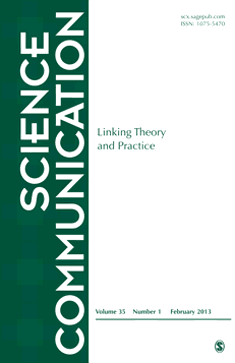
SCIENCE COMMUNICATION
Exploring the Dynamics of Science and Public UnderstandingSCIENCE COMMUNICATION is a premier journal that has established itself as a vital platform for the exploration of the intersection between science, society, and communication practices. Published by SAGE Publications Inc, this journal boasts a commendable impact within the field, evidenced by its 2023 ranking as Q1 in Sociology and Political Science, placing it in the top percentile of its category. With an impressive Scopus rank of 14 out of 1466 in the social sciences domain, it serves as an essential resource for researchers, professionals, and students dedicated to understanding how scientific information is communicated and perceived across various platforms and audiences. Spanning a rich publication history from 1979 to 2024, SCIENCE COMMUNICATION publishes original research, case studies, and reviews that contribute to the development of effective communication strategies in science. Although the journal does not currently offer open access options, its content remains pivotal for fostering informed discourse within academia and beyond. Engaging with this journal is invaluable for anyone interested in enhancing science literacy and engagement in contemporary issues.

EDMETIC
Advancing educational innovation through technology.EDMETIC is a premier open access journal dedicated to the field of educational technology and innovation, published by the University of Córdoba, Faculty of Education Sciences. With its ISSN 2254-0059 and E-ISSN 2254-0059, EDMETIC has been serving the academic community since 2012, providing a platform for the dissemination of high-quality research that explores the intersection of education and digital technologies. Situated in the vibrant city of Córdoba, Spain, this journal invites contributions from both established and emerging scholars worldwide. With a commitment to fostering critical discussions and advancements in educational practices, EDMETIC is pivotal for researchers, professionals, and students interested in the dynamic landscape of educational technology. Authors and readers benefit from its open access model, which ensures that groundbreaking research is accessible to all, promoting a culture of knowledge sharing and collaboration.

Revista Mediterranea Comunicacion-Journal of Communication
Advancing Communication Across CulturesRevista Mediterranea Comunicacion - Journal of Communication, published by UNIV ALICANTE, stands as a significant platform for scholars and practitioners in the fields of Communication and Cultural Studies. With an impact factor that firmly places it in Q2 for Communication and Q1 for Cultural Studies, this open-access journal promotes scholarly dialogue through a rich array of articles, encouraging international discourse that spans various cultural and communicative phenomena. Since its inception in 2010, the Revista Mediterranea Comunicacion has made substantial contributions to understanding contemporary communication dynamics, supported by a growing reputation evidenced by its commendable Scopus rankings—144th in Cultural Studies and 181st in Communication. Researchers, professionals, and students are invited to explore and contribute to this journal, further enhancing the understanding of communication within diverse social contexts.

Metode Science Studies Journal
Bridging Disciplines for a Deeper Understanding of ScienceMetode Science Studies Journal, published by UNIV VALENCIA, BOTANICAL GARDEN UV, is an esteemed open-access journal dedicated to advancing scholarly discourse in the fields of history and philosophy of science and multidisciplinary studies. Since its inception in 2013, the journal has positioned itself as a vital resource for researchers, professionals, and students, fostering an environment for innovative research and cross-disciplinary dialogue. Based in the vibrant city of Valencia, Spain, this journal aims to publish high-quality articles that explore the intricate relationships between scientific practices and philosophical inquiries. With a current impact factor demonstrating its relevance in the academic community, the journal is indexed in Scopus, ranking in the 52nd percentile for history and philosophy of science and the 33rd percentile for multidisciplinary studies. Scholars can access a breadth of research outputs that span from 2015 to 2024, thereby contributing significantly to the intellectual landscape of the respective fields.

Entertainment Computing
Unleashing Creativity Through Technology in EntertainmentEntertainment Computing, published by ELSEVIER SCI LTD, is a leading journal that explores the intersection of computing technology and entertainment, encompassing a wide range of topics from video games to interactive media. With an ISSN of 1875-9521 and an E-ISSN of 1875-953X, this esteemed publication caters to an interdisciplinary audience, including researchers, industry professionals, and students. Since its inception in 2009, the journal has achieved impressive recognition in the academic community, ranking in the Q2 quartile for both Computer Science Applications and Human-Computer Interaction, as well as Software, according to the 2023 category quartiles. The journal's commitment to high-quality, peer-reviewed research is reflected in its Scopus rankings, where it currently stands at Rank #142/407 in Computer Science Software and Rank #62/145 in Human-Computer Interaction. With its focus on innovative research that advances the understanding of how technology shapes our entertainment experiences, Entertainment Computing plays a pivotal role in fostering scholarly discussion and practical applications in the field.
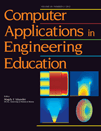
COMPUTER APPLICATIONS IN ENGINEERING EDUCATION
Bridging the gap between technology and engineering learning.COMPUTER APPLICATIONS IN ENGINEERING EDUCATION, published by Wiley, is a leading journal dedicated to the intersection of computer science and engineering education. With its ISSN 1061-3773 and E-ISSN 1099-0542, this journal has become a vital resource since its inception in 1992, providing valuable insights and advancements within its scope. Renowned for its high impact, the journal is categorized in the Q1 in Education and Q1 in Engineering (miscellaneous) quartiles, reflecting its significant contribution to the fields of education and engineering. The journal holds impressive Scopus rankings, including Rank #41 in General Engineering and Rank #38 in General Computer Science, positioning itself within the top echelons of relevant academic disciplines. Although it is not currently an open-access publication, it provides researchers, educators, and students with a platform to explore innovative computer applications in engineering contexts. This journal not only serves as a repository of knowledge but also fosters a community for professionals interested in enhancing educational methodologies through technology.
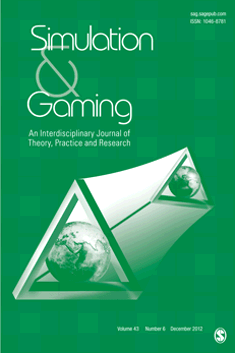
SIMULATION & GAMING
Bridging Disciplines with Engaging MethodologiesSIMULATION & GAMING, published by SAGE PUBLICATIONS INC, is a leading academic journal that explores the intersection of simulation and gaming within diverse fields such as business, social sciences, and computer science. With an ISSN of 1046-8781 and an E-ISSN of 1552-826X, this journal stands out in its commitment to advancing knowledge through high-quality research and innovative methodologies. As a testament to its influence, it is ranked Q1 in Social Sciences and Q2 in both Business, Management and Accounting, and Computer Science Applications, indicating its reputable position among scholars. Researchers, educators, and professionals will find valuable insights into the applications and implications of simulation and gaming, making it an essential resource for cutting-edge developments in these rapidly evolving domains. Access to its comprehensive archives allows for exploration of pivotal studies dating back to 1970, supporting the ongoing dialogue in this interdisciplinary area of research.
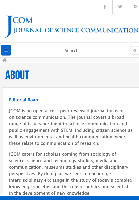
JCOM-Journal of Science Communication
Unlocking Knowledge: Engaging the Public in ScienceJCOM - Journal of Science Communication is a premier, peer-reviewed journal dedicated to enhancing the dialogue between science and society. Established in 2002 by the Scuola Internazionale Superiore di Studi Avanzati in Italy, it has become an essential platform for research in the field of science communication, reflecting the growing importance of effective communication in the advancement of scientific knowledge. The journal boasts an impressive Open Access model, encouraging widespread dissemination of critical research findings. With a notable impact in the Communication category, ranking in the Q2 quartile, and achieving a remarkable 77th percentile in Scopus ranks, JCOM positions itself as a crucial resource for scholars, professionals, and students alike. With a broad scope covering interdisciplinary aspects of science communication, the journal aims to foster innovative research and discussions that bridge the gap between scientific communities and the public. Located in Trieste, Italy, JCOM invites contributions that elevate the standards and practices of communicating science in an increasingly complex world.

International Journal of Information and Communication Technology Education
Advancing educational excellence through technology.International Journal of Information and Communication Technology Education (ISSN: 1550-1876, E-ISSN: 1550-1337), published by IGI Global, stands at the forefront of educational research, focusing on innovative uses of information and communication technologies in the educational landscape. With an impressive impact factor and consistently high rankings—the journal is positioned in the Q3 category for both Computer Science Applications and Education in the 2023 evaluations—this journal serves as a vital platform for scholarly contributions that aim to advance teaching methodologies and enhance learning experiences. Spanning from 2005 to 2024, it explores diverse topics in e-learning and technology-enhanced education, making it an essential resource for researchers, professionals, and students passionate about the intersection of technology and pedagogy. Though specifically not an open-access journal, the invaluable insights it offers foster knowledge dissemination and innovation in the field. Located in the United States, at 701 E Chocolate Ave, Hershey, PA, the journal remains committed to fostering a collaborative and transformative approach to learning in today's digitally-driven society.